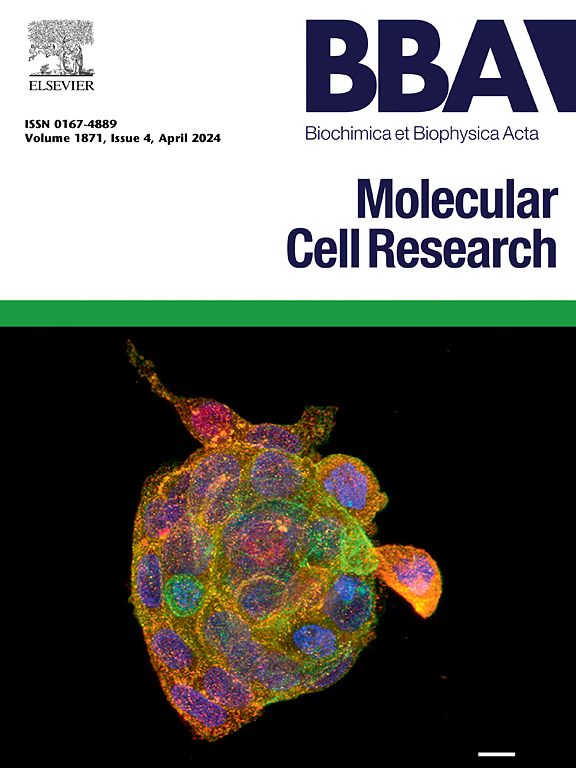Synthesis, characterization and size-dependent cytotoxicity of magnesium ammonium phosphate hexahydrate crystals of different sizes on renal epithelial cells
IF 3.7
2区 生物学
Q1 BIOCHEMISTRY & MOLECULAR BIOLOGY
Biochimica et biophysica acta. Molecular cell research
Pub Date : 2025-07-12
DOI:10.1016/j.bbamcr.2025.120022
引用次数: 0
Abstract
Magnesium ammonium phosphate hexahydrate (MAP) crystals with sizes of 98.5 ± 20.6 nm, 310 ± 67 nm, 1.12 ± 0.34 μm, and 3.23 ± 0.90 μm were synthesized and characterized. These crystals can cause damage to renal tubular epithelial cells (HK−2), which is manifested by crystal-induced cell morphological changes, cell viability, a decrease in superoxide dismutase and mitochondrial membrane potential. In addition, there were crystal-induced increases in reactive oxygen species, lactate dehydrogenase, and malondialdehyde levels, as well as phosphatidylserine ectropion. That is, MAP crystals can lead to cell necrosis and apoptosis, and promote the release of inflammatory cytokines IL-18 and IL-6. The cytotoxicity of MAP crystals has a size effect, that is, the cytotoxicity is: MAP-100 nm > MAP-300 nm > MAP-1 μm > MAP-3 μm. The factors enhancing the cytotoxicity of MAP include small size, large specific surface area, and a more negative crystal surface zeta potential. Nano-crystal MAP-100 nm mainly causes cell death by inducing extensive cell necrosis. When the larger-sized MAP-300 nm, MAP-1 μm and MAP-3 μm crystals acted on HK-2 cells, cell necrosis, apoptosis and autophagy occurred simultaneously. Investigating the relationship between MAP crystal size and cytotoxicity may provide insights into elucidating the mechanism of MAP stone (struvite) formation and preventing its occurrence.
不同大小磷酸铵镁六水晶体的合成、表征及其对肾上皮细胞的细胞毒性。
磷酸镁铵六水合物(MAP)晶体大小为98.5 ±20.6 nm, 310 ± 67 海里, 1.12±0.34 μm和3.23 ±0.90 μm是合成和特征。这些晶体可引起肾小管上皮细胞(HK-2)的损伤,表现为晶体诱导的细胞形态改变、细胞活力降低、超氧化物歧化酶和线粒体膜电位降低。此外,晶体诱导活性氧、乳酸脱氢酶和丙二醛水平的增加,以及磷脂酰丝氨酸外翻。即MAP晶体可导致细胞坏死和凋亡,促进炎性细胞因子IL-18和IL-6的释放。地图的细胞毒性晶体尺寸效应,也就是说,细胞毒性是:地图- 100 nm > 地图- 300 nm > MAP-1 μm > MAP-3 μm。增强MAP细胞毒性的因素包括体积小、比表面积大、晶体表面zeta电位更负。纳米晶体MAP-100 nm主要通过诱导细胞广泛坏死导致细胞死亡。当较大尺寸的MAP-300 nm、MAP-1 μm和MAP-3 μm晶体作用于HK-2细胞时,细胞同时发生坏死、凋亡和自噬。研究MAP晶体大小与细胞毒性的关系,有助于阐明MAP结石(鸟粪石)的形成机制和预防其发生。
本文章由计算机程序翻译,如有差异,请以英文原文为准。
求助全文
约1分钟内获得全文
求助全文
来源期刊
CiteScore
10.00
自引率
2.00%
发文量
151
审稿时长
44 days
期刊介绍:
BBA Molecular Cell Research focuses on understanding the mechanisms of cellular processes at the molecular level. These include aspects of cellular signaling, signal transduction, cell cycle, apoptosis, intracellular trafficking, secretory and endocytic pathways, biogenesis of cell organelles, cytoskeletal structures, cellular interactions, cell/tissue differentiation and cellular enzymology. Also included are studies at the interface between Cell Biology and Biophysics which apply for example novel imaging methods for characterizing cellular processes.

 求助内容:
求助内容: 应助结果提醒方式:
应助结果提醒方式:


